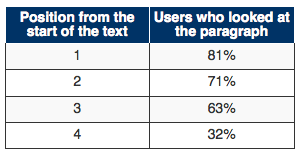 When it comes to website copy, knowing when and what people read is the key to developing an effective, lead-generating site. And while we often hear that people scan instead of reading, there are instances in which web copy (or at least a portion of it) is actually read.
When it comes to website copy, knowing when and what people read is the key to developing an effective, lead-generating site. And while we often hear that people scan instead of reading, there are instances in which web copy (or at least a portion of it) is actually read.
When we write for the web, we tend to aim for copy that’s short, snappy and to the point. After all, study after study claims that people don’t read web copy (or blog posts)—or, if they do, they only scan headlines or subheads.
Yet a recent study from the Nielsen Norman Group disputes those claims. NNG analyzed 1.5 million eye tracking fixations from hundreds of sites and came to a surprising conclusion: people do read websites.
Take a look at this example of a zoo website from NNG’s study. Sure, there’s a lot of copy on the page that isn’t read. But look how many eyeballs zeroed in on that middle paragraph:
What Makes People Read Websites
I love this stuff. And that’s because a lot of what we do is centered around websites that work. That eye-tracking map alone is enough to keep me fascinated for hours. My team and I not only love data—we’re also always on the lookout for a chance to dive deeper and find out why numbers or stats are so important.
In the case of NNG’s report, it includes a lot of helpful pointers to make your website more effective and more widely read by your users, clients, customers and prospects. Here are a few of the key takeaways:
User Experience Matters
A good UX on any website is critical. If your content isn’t organized in a way that makes sense to your audience and, more importantly, gives them what they need, well, the information isn’t going to do them much good. Make sure your site is clearly labeled and easy to navigate. A clearly laid out nav bar is a big help, as are drop-down menus—just don’t get too carried away with multiple categories and sub-categories. Think about why your customers or clients are coming to your site, and make sure you give them what they want and need in a way that’s clear, concise and easy to find.
If You’re Not First, You’re Last
The aforementioned zoo website example is an interesting one, since the most widely read paragraph is fairly far down on the page. NNG analyzed the data and found that, in most instances, users tend to look at the first paragraph:
And that means that it’s a good idea to include your most important information at the top of the webpage. Just as you optimize the first paragraph of your blog post to deliver the key points that will be discussed later in the post, use the top spots on your web page to clearly deliver the information that your users most want to find. Most people don’t do this. Trust me.
Writing Matters
Even though writing for the web is different than, say, writing for print publications, it still boils down to one key trait: good writing. And we love that the folks at NNG came to this same realization after analyzing their data.
“However, our eye tracking data also detected a third ingredient for converting users from scanners to readers: high-quality writing,” writes Jakob Nielsen. Have I mentioned yet that I’m an unabashed Jakob Nielsen fangirl? Oh, the grey matter there. Swoontastic.
I digress. High-quality writing. Isn’t that the truth? After all, how long do you stick with a website or blog post if the content is poorly written? I’m guessing you‘re like me and don’t stay around long at all—and if the writing is bad enough, you might just head over to that site’s competitor to find what you do need.
Lesson learned? Your web content counts—so treat it as such. If you’re not confident in your writing abilities, it might be worth it to hire a freelance writer to craft your site’s content. Sure, it’s an investment, but your website is the hub of your digital operations—and if it isn’t well-written, optimized and user-friendly, it can have a serious impact not just on your brand awareness, but also your bottom line.
What’s your take on NNG’s findings? Have you stumbled on a website that you’ve actually read, or do you still tend to scan web content? I’d love to know how your habits compare to the study stats.
Image: break.things via Compfight cc
